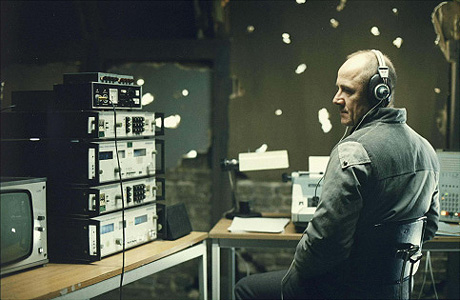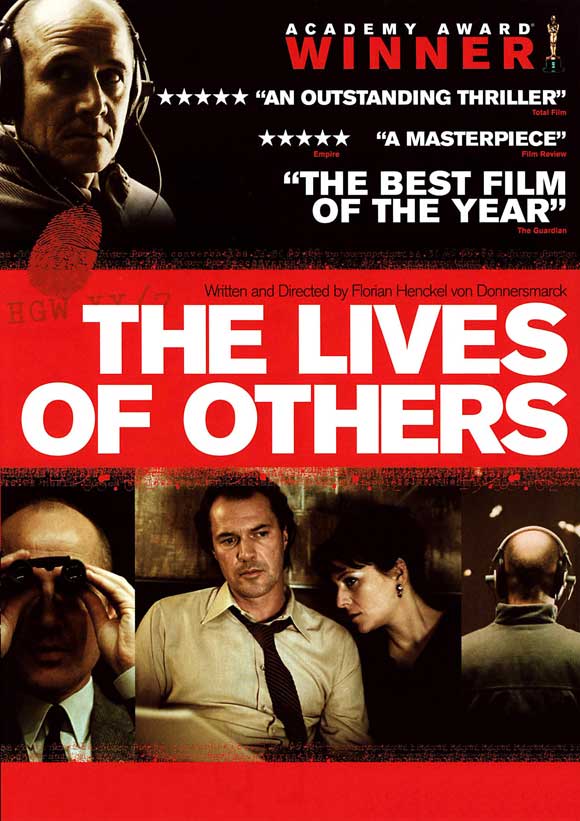Music overcomes oppression.
People can change for the better even within the crucible of dictatorship. Set in the bare, gray landscape of totalitarian East Germany in 1984 [1, read this note!], a state security agent named Wiesler plies his trade of eavesdropping on his own people. Rock-like jaw, empty face, and barren soul greet the viewer as Wiesler teaches his craft to young people in the opening sequences. Everything about Wiesler is committed to his Communist leaders including his terse conversation, searing gaze, and Spartan apartment—an apartment so bare, the Spartan’s would be seen as materialists in comparison.
Prompted by a “higher-up’s” love interest in the actress Christa-Maria, Wiesler begins his campaign of covert espionage on Dreyman, the only successful playwright to come out of East Germany who is also heralded by The West. In comparison to Wiesler, Dreyman has a flaccid conscience. He wants desperately to speak out about the subjugation of his own people. Yet, conflicted because of the physical largess showered on him by the government, Dreyman is hobbled, not by the chains of tyranny but by the shackles of complicity.
Separately, the two men begin their metamorphosis. Wiesler steals a book by Brecht from Dreyman’s study. Mind pried open by reading and the entrancing music heard during his surveillance, Wiesler, without words, begins to question the squashing of aesthetics and life itself. The once proud interrogator is softened by the wedge of human goodness, latent in him all these years. Given opportunity to imprison a young man’s father who deigned to call the stasi (East Germany’s secret police) the brutes they were, he suddenly refrains. Transformed by an internal prompting, Weisler continues covering Dreyman’s new found conviction.
For his part, Dreyman is moved to action by his recluse director friend Jerka who gives Dreyman a musical piece entitled, “Sonata for a Good Man” before committing suicide. Knowing that he must speak out about the atrocities in his country, Dreyman writes an article for The West which points out the suicide rate in East Germany. Dreyman’s new found courage is tested and tried in ways the movie bridges over time.
 The Lives of Others is a film for the ages; a brilliant directorial debut by Florian Henckel von Donnersmarck. Looking for an idea for a class he was taking at the time, Donnersmarck uses a statement by Lenin and his inability to produce the Russian Revolution while also trying to enjoy Beethoven’s ‘Appassionata.’ Music is the catalyst of change in Wiesler, the means of nerve for Dreyman. The Lives of Others compels the viewer from beginning to perfect ending to consider what prompts any goodness in man.
The Lives of Others is a film for the ages; a brilliant directorial debut by Florian Henckel von Donnersmarck. Looking for an idea for a class he was taking at the time, Donnersmarck uses a statement by Lenin and his inability to produce the Russian Revolution while also trying to enjoy Beethoven’s ‘Appassionata.’ Music is the catalyst of change in Wiesler, the means of nerve for Dreyman. The Lives of Others compels the viewer from beginning to perfect ending to consider what prompts any goodness in man.
(Subtitled) Rated R for violence, nudity, and sexuality.
All revisionist history movies, such as innumerable Che films, should reconsider their assumptions. Mark Eckel teaches at Capital Bible Seminary (first published 24 Aug 07).
[1] The reviews of this film show either historical naiveté or passive acceptance of the East German police state under Communism. One would get the general impression sans the 20th century record that the stasi were more of a general nuisance rather than the tyrannical arbiters of life and death they were. One wonders if the phrase “abuse of power by the reactionary and deeply ensconced East German leadership” (Kent Turner, salon.com) is a true depiction of peoples’ freedoms trounced under the hobnailed boot.

